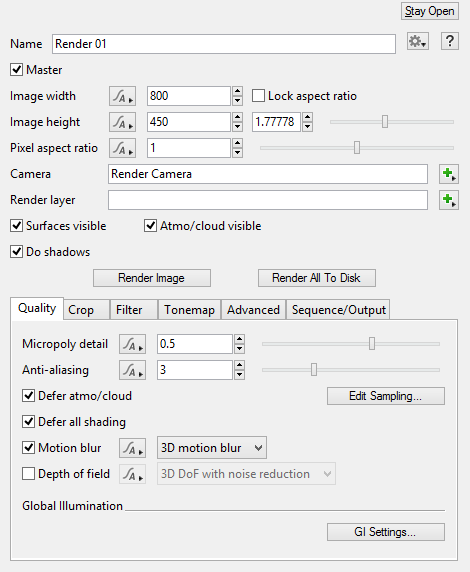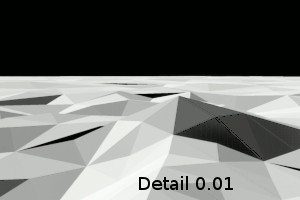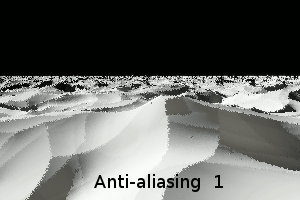Render
Node Type: Render
Node Description and Purpose
The Render node contains the settings used to produce final renders and can also be used to start rendering images and animation sequences. The Render node works in concert with the Camera node to create a render of your scene from a specific perspective.
Basic controls include the Width and Height of your output image, the camera from which your scene will be rendered, overall scene Detail, and Antialiasing. Many additional controls for fine-tuning scene detail and quality are also provided, including Global Illumination (GI) settings, as well as Contrast and Gamma Correction functions. You can also render partial crops of your select cameras view using the Crop Region functions. Sequence/Output allows you to output a sequence of images for animation (in versions of Terragen that include Animation features).
Terragen 2 only: When you start a new project in Terragen 2 there are two render nodes created for you. One is called "Full Render" and the other is called "Quick Render". Both of these nodes are Render nodes. The difference between them is that "Full Render" has preset settings more suitable to a final render whereas "Quick Render" has lower quality presets suitable for a quick preview render.
Settings:
- Master: Check this to make the node the Master render node. The Master render node is the one which will be used to render projects loaded from the command line or a batch file.
- Image width: This param sets the width of the rendered image in pixels.
- Image height: This param sets the height of the rendered image in pixels.
- Lock aspect ratio: If this is checked then the image aspect ratio is locked. When you make changes to the image width or height the other param will be changed so that the aspect ratio of the image is maintained.
- Aspect ratio: You can change the aspect ratio for the image using the controls under the Lock aspect ratio param. Values greater than 1 will make the image wider and values less than 1 will make the image taller.
- Camera: This param sets the Camera node used for rendering the image. A Render node must have a camera assigned to it before it can render.
- Surfaces visible: If this is unchecked then surfaces (e.g. terrain, vegetation etc.) are rendered as "holdouts". This means they will appear to the camera as if they were black and will have a value of 0 in the alpha channel of the rendered image.
- Atmo/cloud visible: If this is unchecked then the atmosphere and clouds will not be directly visible to the camera. It will appear as though there is no atmosphere, but the atmosphere may still affect the lighting of the scene.
- Do shadows: Uncheck this to stop shadows rendering.
- Render Image: Clicking this button will start rendering an image. If you want an image to be automatically saved to disk when the render finishes, use "Render All To Disk" instead.
- Render All To Disk: Clicking this button will start rendering an image, and when it finished it will save the image to the path and filename specified on the Sequence/Output tab. If "Extra output images" is enabled on the Sequence/Output tab it will also save any render elements that are enabled.
Quality Tab
- Detail / Micropoly detail: This setting controls the detail of the render. Although you can enter any value here the normal range is from 0 to 1. A setting of 0.8 is high quality. Increasing this value can lead to longer render times.
- Anti-aliasing: This controls the amount of anti-aliasing in the image. This is one of the most important settings for controlling the quality of your image and the time it takes to render. This parameter is also shown in the Render Pixel Sampler. The square of the anti-aliasing number tells you the maximum number of primary rays that are traced per pixel of the image, or in other words the maximum samples per pixel. An anti-aliasing value of 3 means that up to 9 samples can be taken per pixel; a value of 8 means that some pixels may take up to 64 samples, and this is usually enough for very good images. Adaptive sampling techniques are used to avoid taking the maximum number of samples where the sampler detects that the contrast between adjacent samples is below some threshold. This can be an effective way to concentrate anti-aliasing work where it is needed most, to increase quality and reduce the render time.
- Defer atmo/cloud: If this is checked the atmosphere is rendered using raytracing. This can give better looking results than the normal micropolygon renderer and might be faster. However it may be slower for some scenes.
- Edit sampling…: Clicking this button opens the Render Pixel Sampler which lets you set advanced sampling parameters.
For more information on how Terragen renders a scene, review the Rendering Methods page.
Additional tabs for Render[edit]
A single object or device in the node network which generates or modifies data and may accept input data or create output data or both, depending on its function. Nodes usually have their own settings which control the data they create or how they modify data passing through them. Nodes are connected together in a network to perform work in a network-based user interface. In Terragen 2 nodes are connected together to describe a scene.
A parameter is an individual setting in a node parameter view which controls some aspect of the node.
A single element of an image which describes values for color and/or intensity, depending on the color system which the image uses. Groups of ordered pixels together form a raster image.


